Do NOT follow this link or you will be banned from the site!
Feed aggregator
At Meta Antitrust Trial, Zuckerberg Calls TikTok a Competitive Threat
The former chief operating officer took the stand in a landmark antitrust trial accusing Meta of quashing competition through acquisitions.
Google Messages is testing some useful upgrades – here are 5 features that could be coming
- Google is testing even more new features in its Messages beta app
- These include an expanded 14-line message view and new RCS message labels
- While these are still in beta testing, they could start rolling out to users this month
Over the past couple of months, Google has been doubling down on eradicating all traces of Google Assistant to make Gemini its flagship voice assistant, but amidst the organized Gemini chaos, Google has been paying a lot of attention to improving its Messages app, giving it some much-needed TLC.
It’s safe to say that the new revisions to the Google Messages app have significantly improved its UI. Its new snooze function for group chats also comes to mind, but Google is still in its beta testing era. For a while, Google was experimenting with an easier way to join group chats, following WhatsApp’s footsteps. Now, it’s testing five more features that could make up the next wave of Google Messages upgrades this month.
Although these features are in beta, there’s been no comment on whether they’ll be officially rolling out to users. With that said, we’ll be keeping an eye out for any further updates.
Google expands its 4-line text field limit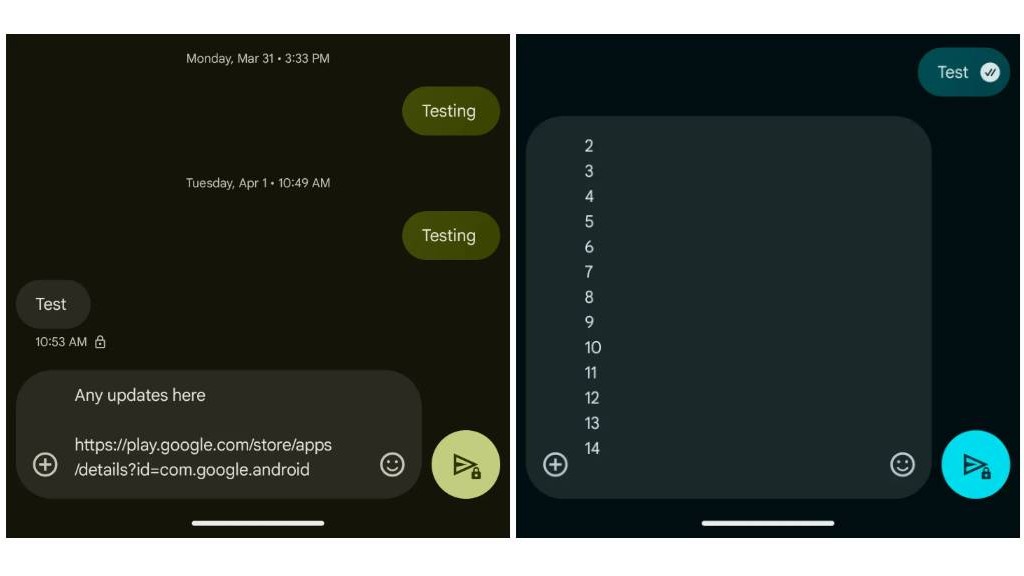
Just a few weeks ago, we reported on a new upgrade found in Google Messages beta indicating that Google would get better at handling lengthy text messages.
For a while, Google Messages users have been restricted to a four-line view limit when sending texts, meaning that you would need to scroll to review your entire message before sending. This is particularly frustrating when sending long URL links.
But that could soon be a thing of the past, as 9to5Google has picked up a new beta code that reveals an expanded message composition field on the Pixel 9a that now reaches up to 14 lines.
New RCS labelsRecently, Google has been testing new in-app labels that could distinguish whether you’re sending an SMS or RCS message.
Thanks to an APK teardown from Android Authority, the labels found in beta suggest that soon you’ll be able to see which of your contacts are using RCS in Messages, adding a new RCS label to the right side of a contact’s name or number.
Unsubscribe from automated textsThis is a feature we’re quite excited to see, and we’re hoping for a wider rollout this month. A few weeks ago, an unsubscribe button was spotted at the bottom of some messages, which could give users an easier way of unsubscribing to automated texts and even the option to report spam.
When you tap this, a list of options will appear asking you for your reasons for unsubscribing, which include ‘not signed up’, ‘too many messages’, and ‘no longer interested’ as well as an option for ‘spam’. If you select one of the first three, a message reading ‘STOP’ will be sent automatically, and you’ll be successfully unsubscribed.
Read receipts gets a new look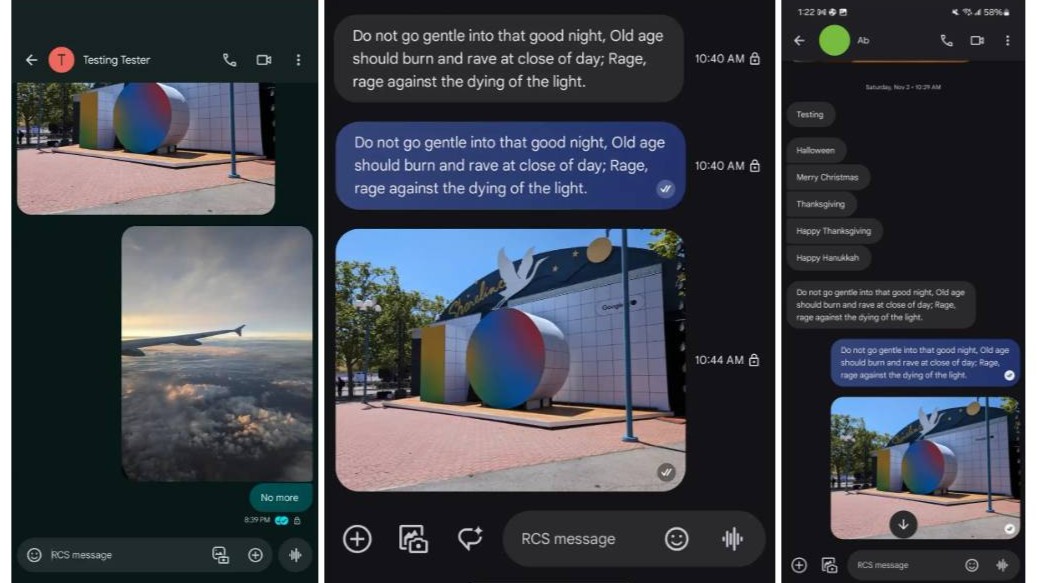
Google could introduce another revamp of how you can view read receipts in the Messages app. In November 2024, Google tested a redesign of its read receipts that placed the checkmark symbols inside the message bubbles, which used to appear underneath sent messages.
In January, Google tested another small redesign introducing a new white background, which could roll out soon, and while this isn’t a major redesign, it’s effective enough to make read receipts stand out more.
Camera and gallery redesign, and sending ‘original quality’ mediaWe first noticed that Google Messages was prepping a new photo and video quality upgrade. In March, more users started to notice a wider availability, but it’s still not yet fully rolled out, meaning it could be one of the next new updates in the coming weeks.
Essentially, Google could be rolling out a new option that allows you to send media, such as photos and videos, in their original quality. This will give you the choice of the following two options:
‘Optimize for chat’ - sends photos and videos at a faster speed, compromising quality.
‘Original quality’ - sends photos and videos as they appear in your phone’s built-in storage.
You might also like- Google Messages emoji reaction 'bug' is actually just a test for beta users, Google confirms
- Google Messages finally reverses an annoying change, making it easier to organize your contacts
- Google Messages could soon tell you which group chat members have read your messages - and I'm ready to snoop like never before
Amazon Sellers Struggle with Trump’s Tariff Plans
An Illinois couple who sell party supplies on Amazon have been frantically trying to understand and adapt to new costs caused by President Trump’s tariffs.
Claude tipped to get its answer to ChatGPT’s Advanced Voice Mode soon - is adding an AI voice to a chatbot yet another tick box exercise?
- Anthropic is expected to launch a Claude voice mode
- A report from Bloomberg states that the voice mode will launch with three voices
- Voice modes, research tools, reasoning models: Same-same, but different
Anthropic's Claude AI chatbot is set to be upgraded with a new voice mode, as the company with minority Amazon ownership looks to catch up with the likes of ChatGPT and Gemini.
According to a new report from Bloomberg, Claude's new feature called "voice mode" could launch as soon as this month.
The info comes from "a person familiar with the matter who was not authorized to discuss private matters," who says the AI voice assistant will have three voices at launch.
The voices titled Airy, Mellow, and Buttery will give Claude users the chance to pick from three diverse accents, although nothing is confirmed as of yet, and Anthropic could opt for more or fewer voices at launch.
Claude's closest competitors, OpenAI's ChatGPT and Google's Gemini, both have their own respective AI voice modes. ChatGPT Advanced Voice Mode and Gemini Live allow users to chat with AI, making the experience more conversational and natural.
With Claude potentially throwing its name into the mix, consumers will have another AI voice assistant to choose from. But it begs the question: Does the population even care?
Just another AI tick boxAI chatbots seem to follow in each other's footsteps. Whether that's the introduction of a reasoning model, a research model, an image generation model, or, in this case, a voice mode.
Whether you're using ChatGPT, Gemini, DeepSeek, or even Claude, the user experience with each chatbot is getting so similar that regardless of which one you use you'll end up with a similar result.
Obviously, in a rapidly moving industry like AI, it's a race to release your product faster than your competitors, but as a consumer, we end up with. constant new releases of the same kind of feature, repackaged and marketed by competing tech companies.
Claude's voice mode, when it arrives, will be yet another tick-box exercise for an AI company looking to have its product on a level playing field with its competition.
As a consumer, I want these AI companies to throw out the playbook and try new things. AI voice modes are great, and they make chatbots even easier to use.
When it comes to new AI software launches, however, I've started to wonder: Does the company even care? Or is this just a tick-box exercise?
Hopefully, Claude's voice mode innovates the world of AI voice assistants, but until I see its potential, I fully expect yet another AI release that's exactly the same as the 10 other options out there.
You might also likeWindows 11 is about to get a nifty shortcut for copying out all the text from an image
- Windows 11 is powering up the Snipping Tool in testing right now
- A new feature allows you to copy all the text from an image straight away
- There’s no need to take a screenshot first, as was previously the case, so this is a neat time-saver
Microsoft is making it even easier for Windows 11 users to be able to extract text from images (or any content) on the screen.
Windows 11 already has this OCR-powered (Optical Character Recognition) ability, as you may be aware, but at the moment, it’s necessary to take a screenshot first with the Snipping Tool before you can extract text from that image.
With a new update for the Snipping Tool that’s just been released (which was leaked previously), you don’t need to grab a screenshot to perform text extraction any longer – although bear in mind this is still in testing at this point (so may still be wonky).
As Neowin reports, with preview version 11.2503.27.0 of the Snipping Tool, you can simply hit the Windows + Shift + S keys together, and this will pop up the capture bar for the tool.
However, instead of having to create a snip (screenshot), the ‘text extractor’ option will be right there in the bar, so you can just click that, with no need to save a screen grab first.
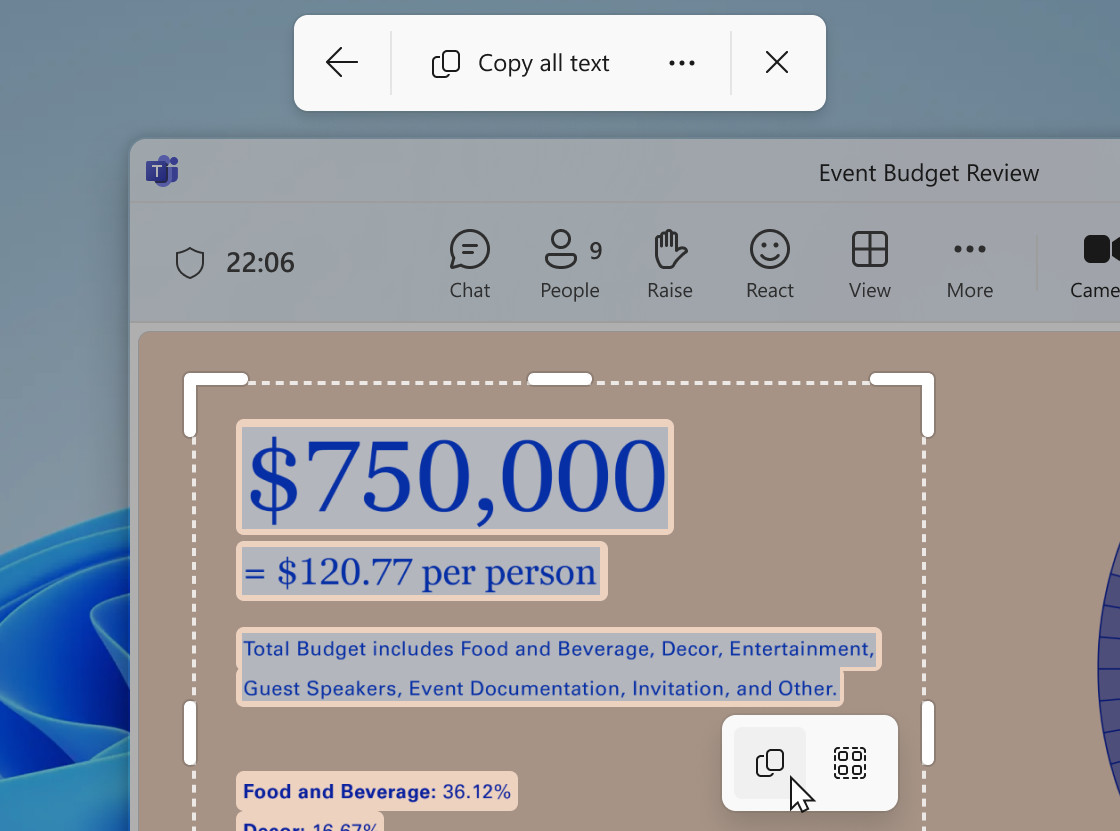
Essentially, this is directly integrating the ability to extract text from images (or any screen content) into Windows 11, with no additional steps needed, mirroring the functionality present in Microsoft’s PowerToys suite of tools (for advanced Windows users) – and it’s definitely going to be appreciated by folks who use this capability.
It’s obviously less of a hassle than having to clear the hurdle of actually grabbing a screenshot, if all you’re interested in doing is copying all the text that’s currently visible on your monitor.
I say all the text, but that’s only what happens if you use the ‘Copy all text’ option provided. If you just want a specific portion of text, you can manually select and extract only those words (it’s also possible to remove line breaks if you want).
Microsoft is slowly expanding Windows 11’s OCR powers, and you may recall that late last year, the Photos app got Optical Character Recognition built in to pull text from images directly within the application.
You may also like...- Microsoft warns that anyone who deleted mysterious folder that appeared after latest Windows 11 update must take action to put it back
- Windows 11 is getting a very handy change to the taskbar, as Microsoft takes a leaf from Apple’s Mac playbook
- Windows 11 fully streamlined in just two clicks? Talon utility promises to rip all the bloatware out of Microsoft’s OS in a hassle-free way
ChatGPT gets a useful new home for your AI images – and it could be the first step towards OpenAI's new Instagram rival
- The ChatGPT app and web interface is getting a new Library tab
- This is where all your AI-generated images are now kept
- The feature is rolling out now for all users
ChatGPT's recent image update almost broke the internet, and certainly put a ton of pressure on OpenAI's huge stack of graphics processors – and now users are getting a dedicated space inside the chatbot's interface for their AI pictures.
As announced by OpenAI (via The Verge), the new Library tab shows up across the mobile apps and the web interface for ChatGPT. It's available universally too, whether or not you pay for a subscription to the AI bot.
The update has already shown up inside the web interface for my own account, and it's all pretty straightforward to use: the tab collects every image you've generated, across every chat in your history, and you can click on a picture for edit and download options. You can also create a new image from the Library section.
Delete a chat, and the included images get wiped from the Library tab as well. There isn't anything in the way of image search or filtering as yet, but of course these features could be rolled out in time as the feature evolves.
The social aspectAll of your image creations, all in one place.Introducing the new library for your ChatGPT image creations—rolling out now to all Free, Plus, and Pro users on mobile and https://t.co/nYW5KO1aIg. pic.twitter.com/ADWuf5fPbjApril 15, 2025
It seems as though we're seeing a new AI image trend appearing every week, whether it's Studio Ghibli-inspired renderings, turning people into action figures, or imagining what your pet might look like as a human being.
Given the recent boost in the quality of the images ChatGPT can make, across free and paid tiers, it makes sense for OpenAI to create a separate space to hold them – previously users had to dig through individual conversations to find them.
It also links into the rumors we've heard about OpenAI working on a social network. These plans are apparently in their early stages, but if ChatGPT were to become more social, it's easy to see how image sharing could be a big part of that: like Instagram, but with AI-generated images and videos dominating.
The move would give OpenAI access to even more user data to train on, too. Would you sign up for yet another social media network, if it was focused around AI? And would your AI content have what it takes to go viral? Let us know in the comments.
You might also likeTaiwan’s Chip Companies Are Caught in the U.S.-China Tariff War
President Trump has threatened tariffs on Taiwan and the chip industry. China has signaled it will not let the trade war keep it from the technology it needs.
Nvidia Says U.S. Will Restrict Sales of More of Its A.I. Chips to China
The restrictions are the first major limits the Trump administration has put on semiconductor sales outside the United States, toughening rules created by the Biden administration.
Google’s new AI model could someday let you understand and talk to dolphins
- Google and the Wild Dolphin Project have developed an AI model trained to understand dolphin vocalizations
- DolphinGemma can run directly on Pixel smartphones
- It will be open-sourced this summer
For most of human history, our relationship with dolphins has been a one-sided conversation: we talk, they squeak, and we nod like we understand each other before tossing them a fish. But now, Google has a plan to use AI to bridge that divide. Working with Georgia Tech and the Wild Dolphin Project (WDP), Google has created DolphinGemma, a new AI model trained to understand and even generate dolphin chatter.
The WDP has been collecting data on a specific group of wild Atlantic spotted dolphins since 1985. The Bahamas-based pod has provided huge amounts of audio, video, and behavioral notes as the researchers have observed them, documenting every squawk and buzz and trying to piece together what it all means. This treasure trove of audio is now being fed into DolphinGemma, which is based on Google’s open Gemma family of models. DolphinGemma takes dolphin sounds as input, processes them using audio tokenizers like SoundStream, and predicts what vocalization might come next. Imagine autocomplete, but for dolphins.
The model is very slim and can run on a Google Pixel. WDP is already deploying DolphinGemma in the field this summer, using Pixel 9s in waterproof rigs. These models will be listening in, identifying vocal patterns, and helping researchers flag meaningful sequences in real time.
Flipper speaksBut the ultimate goal here isn’t just passive listening. WDP and Georgia Tech are also working on a system called CHAT (short for Cetacean Hearing Augmentation Telemetry), which is essentially a two-way communication system for humans and dolphins. CHAT lets researchers assign synthetic whistles to objects dolphins like, including seagrass and floating scarves, and then waits to see if the dolphins mimic those sounds to request them. It’s kind of like inventing a shared language, except with underwater microphones instead of flashcards.
DolphinGemma doesn’t just analyze dolphin sounds after the fact; it helps anticipate what sounds might be coming, enabling faster response times and smoother interactions. In essence, it’s like a predictive keyboard for dolphins. The whole project is still in an early stage, but Google plans to open-source DolphinGemma later this year to accelerate progress.
The initial model is trained on the vocalizations of Atlantic spotted dolphins, but it could theoretically be adapted to other species with some tuning. The idea is to hand other researchers the keys to the AI so they can apply it to their own acoustic datasets. Of course, this is still a long way from chatting with dolphins about philosophy or their favorite snacks. There’s no guarantee that dolphin vocalizations map neatly to human-like language. But DolphinGemma will help sift through years of audio for meaningful patterns.
Dolphins aren't the only animals humans may use AI to communicate with. Another group of scientists developed an AI algorithm to decode pigs' emotions based on their grunts, squeals, and snuffles to help farmers understand their emotional and physical health. Dolphins are undeniably more charismatic, though. Who knows, maybe someday you'll be able to ask a dolphin for directions while you're sailing, at least if you don't drop your phone in the water.
You might also likeOpenAI might build its own social network, and we think we know why
In what we can only assume is a potential thumb in the eye of Elon Musk, Sam Altman's Open AI is reportedly considering building a social network, possibly inside ChatGPT.
This comes via a new report from The Verge, which claims this week that the social network possibly being built on top of OpenAI's AI services is only in the "early stages." Still, it could set up ChatGPT and other OpenAI platforms for a head-to-head battle with Grok, a generative AI platform built on top of Elon Musk's X (formerly Twitter).
There are essentially no details about what this social platform might look like, and OpenAI has little experience with shareable content outside of what its models can generate and what you can see in Sora (the video generation system) of other people's creations.
Take that, XThe fact that this rumor is out there might have little to do with behind-the-scenes development and more to do with Altman's ongoing battle with former partner Musk.
The pair founded OpenAI together before Musk walked away in 2018. He has since criticized and sued OpenAI for, among other things, becoming, in part at least, a for-profit entity (see OpenAI's partnership with Microsoft and the rise of Copilot).
Let's assume for a moment, though, that this is real. Why would OpenAI want to build a social network? In a word: data.
If millions flock to the platform and then start, I guess, sharing AI-generated memes on it, they'll be dropping a ton of rich data into the OpenAI system. If users allow it, future versions of the GPT model could be trained on it. Real data and activities that show how real people think, talk, act, create, etc, can be invaluable to a young generative model.
Social timing is everythingI wonder if this might've made more sense a year or two ago when Musk took over Twitter, transformed it into X, removed many of the protective content guardrails, and turned it into a social media hellscape. It was in that moment that Meta's Threads first rushed in. It was followed in notoriety by Bluesky. Both of them are distributed social networks, meaning no one owns your identity or your data.
Their growth has been remarkable, and it stands in contrast to X's fortunes. Depending on who you talk to, active user growth is stagnant or shrinking. But that doesn't mean the public's appetite for more alternative platforms is growing. Threads' growth has slowed, and Bluesky is relatively small compared to X and Threads.
The action is mostly on image and video-based social platforms like Snapchat, TikTok, Instagram Reels, and YouTube Shorts. The Verge report does not mention video, which leads us to assume this could be another micro-blogging-style network – something no one necessarily needs or, perhaps, wants.
Even so, as an opportunity to cause Elon Musk a little more agita, it's probably a worthy trial balloon from Altman.
You might also likeCouldn’t install Windows 11 24H2 because of your wallpaper? Microsoft has finally lifted blocks on upgrades due to customization apps – with some catches
- Windows 11 24H2 couldn’t be installed by the users of some wallpaper customization apps
- This was because of compatibility issues with said apps and 24H2
- Microsoft has now resolved those problems, for the most part anyway
Microsoft has finally lifted a compatibility block preventing some Windows 11 users from upgrading to the latest version of the OS because they had certain third-party wallpaper apps installed.
These are apps that let you install custom wallpaper on your Windows 11 machine, and the applications in question didn’t play nice with Windows 11 24H2, misfiring in various ways. That included causing errors, glitches with the wallpapers themselves, vanishing desktop icons, or even issues with virtual desktops.
Windows Central noticed that Microsoft has now marked these problems as fixed in a Windows 11 release health status update. So, those with said wallpaper apps are okay to go ahead and install the 24H2 update.
Well, in theory anyway, although there are some caveats here, which I’ll come onto next.
You may recall that this compatibility block was put in place right when 24H2 first came out, at the end of September last year, so it has taken quite some time to smooth over these issues – and there’s a reason for that, too.
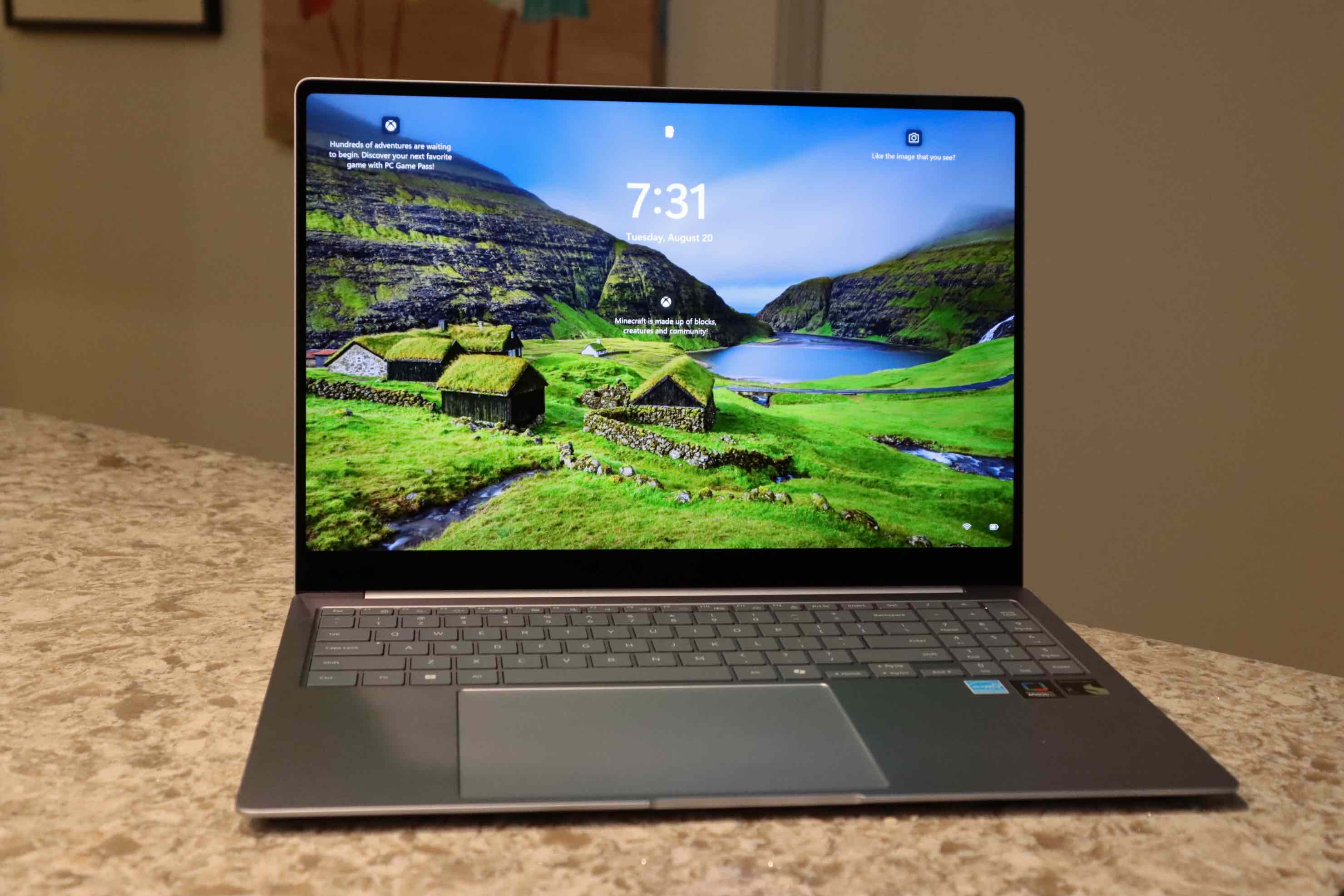
As noted, there are some catches here, as Microsoft tells us in its release health dashboard update.
For starters, the compatibility block is only being gradually removed, so you may be waiting a bit longer yet, depending on your PC configuration and the exact app you have installed.
Microsoft explains: “Note that several wallpaper applications are currently included in this compatibility hold. For this reason, the specific timing of the resolution of this issue on a given device may depend on the application being used and the timing of that application’s update. As new versions and updates are released for these applications by their respective developers, it’s expected that these issues will be resolved.”
Hence the lengthy wait for the resolution of this affair, as it seems that Microsoft wasn’t tinkering with Windows 11 24H2 itself to make these apps work, or at least not doing much in the way of that. Rather, it was apparently waiting on the individual app developers to make their software good with 24H2 themselves.
Microsoft further notes that when you fire up the Windows 11 24H2 installation process, you might see a message telling you to uninstall a wallpaper app. You’re advised to either do this – and just dump the wallpaper app for now – or try updating the app, as said prompt might have appeared because you’re running an older version of the program.
In other words, updating the wallpaper app and trying to install Windows 11 24H2 again may work – but if not, you’ll likely have to remove the application.
Windows 11 24H2 has a history of issues with third-party customization software going back well before release, deep in its testing phase when some popular utilities were banned (to the chagrin of some Windows Insiders). Because 24H2 is built on an entirely new underlying platform, Germanium, this has caused a whole lot more problems than any other update for Windows 11 thus far.
And while such a big shift could be expected to be a headache, and trigger more bugs than normal, the amount we’ve witnessed has essentially been a minor avalanche, and a distinctly unpleasant experience for some Windows 11 users.
You may also like...- Microsoft warns that anyone who deleted mysterious folder that appeared after latest Windows 11 update must take action to put it back
- Windows 11 is getting a very handy change to the taskbar, as Microsoft takes a leaf from Apple’s Mac playbook
- Windows 11 fully streamlined in just two clicks? Talon utility promises to rip all the bloatware out of Microsoft’s OS in a hassle-free way
Google Photos is getting a big overhaul - here are 3 new features you should look out for
- As well as making room for more Gemini, Google has been updating its photo and video sharing service
- One of the new features includes Google Photos integration in the Gemini app
- While one of the features is still a rumor, we hope that it will be rolled out soon
It’s a busy and certainly an interesting time for Google at the moment, and it’s not just because Gemini is slowly taking over. While the company is doubling down on Gemini’s integration across the board of its services, it’s taking the time to seriously upgrade other platforms under its broad umbrella - Google Photos being one of them.
Just as Google Messages has been testing some useful upgrades, the company hasn’t forgotten about its photo sharing and storage software, which has also received its fair share of updates and new features, big and small. Two of them are very recent rollouts for Google, and though the third is only a speculation as of now, we’re hoping to see it come to fruition in the near future.
Google Photos gets Gemini integration on Android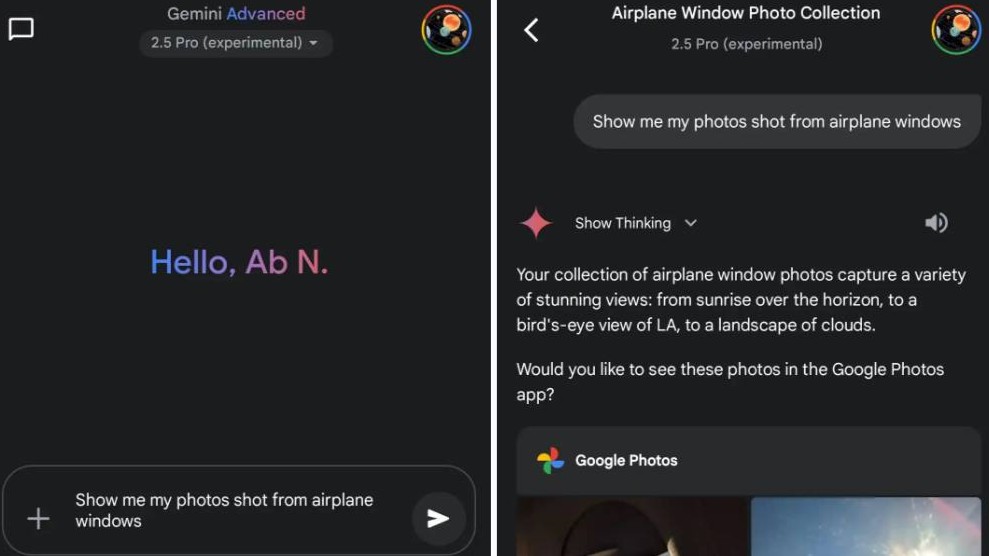
In October 2024, Google Photos rolled out ‘Ask Photos,’ an AI search tool powered by Gemini that allows you to use natural language questions to filter through your gallery in the Photos app. With this new integration, Android users will be able to connect it to Google Photos and find photos inside the Gemini app itself.
According to 9to5Google, there are two sides to this new integration, the first allowing you to find images and videos based on the following:
- Your saved faces and relationships in Google Photos
- The location / date a photo / video was taken on
- A description of what’s in a photo
- Conversation with the Gemini app
For example, you can use prompts such as ‘Find my photos of Alex’, ‘Show me recent selfies’, and ‘Show my photos from my most recent trip’. The second part allows you to ask about specific details in your photos and videos, such as ‘What are the top 10 things we saw on our last trip?’ - similar to the Ask Photos function in the Google Photos app.
Dark mode for Google Photos’ web versionWhether you use Google Photos or not, you probably use dark mode settings on other platforms - for me, it’s always turned on when I'm using YouTube or TikTok. For a while, dark mode was exclusive to the Google Photos mobile app, but just a few weeks ago, Google finally brought it to the web version.
It’s a small upgrade for Google Photos, but one that will be very popular with users for sure. You can activate dark mode for Google Photos on the web very easily:
- Head to photos.google.com in your web browser
- Click Settings, and then go into the Appearance section
- From there, you can select your choice from different options, including Light, Dark, or Use Device Default
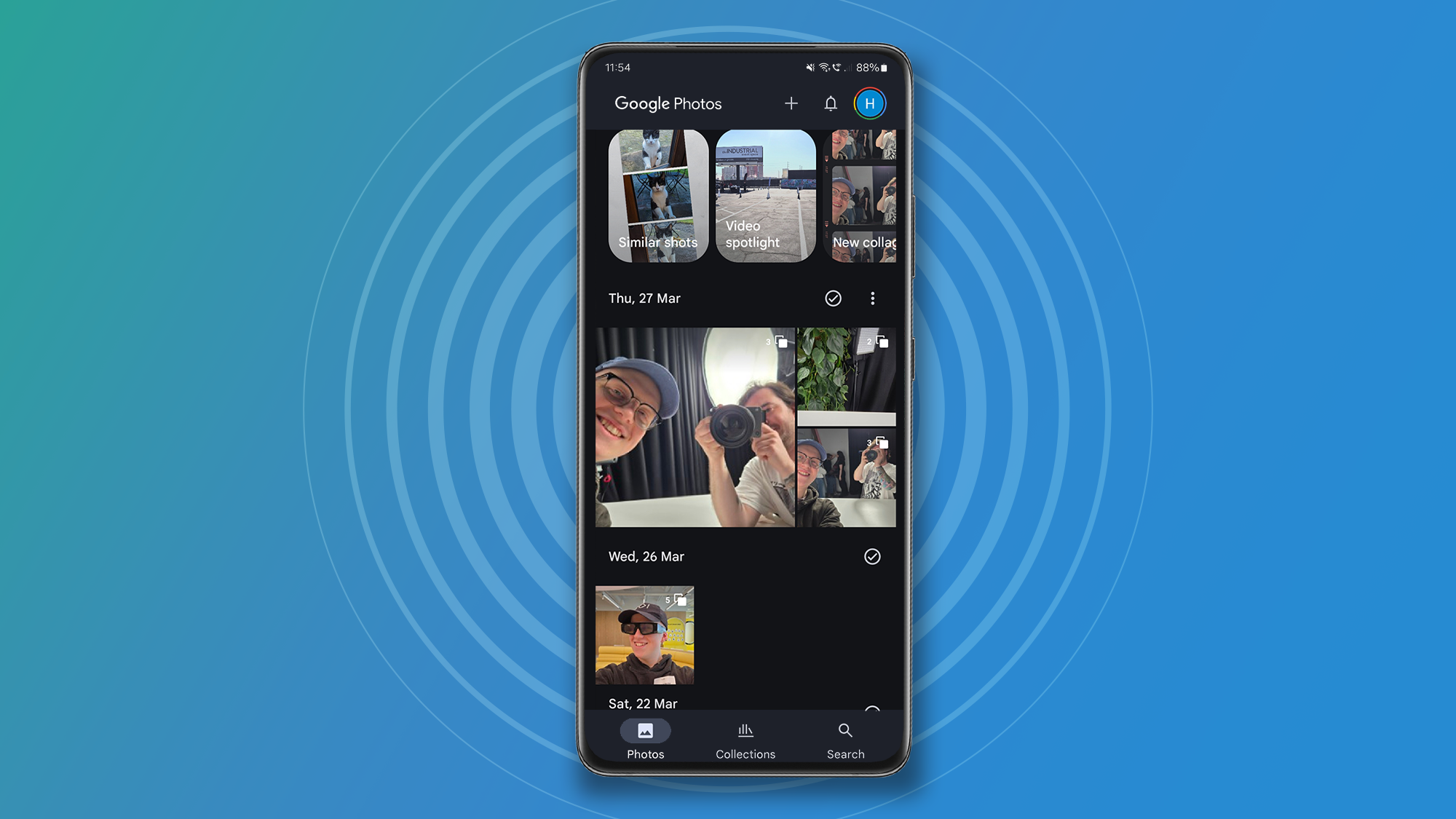
While this is still speculated, it could be a great design overhaul and one that could make managing your photo library a little smoother.
We first spotted this a few weeks back following a leak shared by Android Authority, which pointed to possible changes we could see in the future, one of which shows the ‘Today’ heading no longer having a checkmark next to it but with what looks like a filter icon instead. Additionally, the leak shows a floating search bar in place of the usual Photos Collections and Search tabs.
You might also likeStarship blooper: Windows 10 update gets weirdest bug yet
- Windows 10 recently got a patch tinkering with the Recovery Environment
- Some users are seeing an error message saying the patch failed to install
- In fact, the update installed just fine, and the error message is the error
Some Windows 10 users are encountering an error message after applying a fresh patch for the operating system, informing them that the update failed – when in fact it didn’t.
Neowin spotted the update in question (known as KB5057589) which was released last week (separately from the main cumulative update for April) and tinkers with the Windows Recovery Environment (WinRE) on some Windows 10 PCs (versions 21H2 and 22H2).
Far from all Windows 10 users will get this, then, but those who do might be confronted by an error message after it has installed (which is visible in the Windows Update settings page).
It reads: “0x80070643 – ERROR_INSTALL_FAILURE.”
That looks alarming, of course, and seeing this, you’re going to make the fair assumption that the update has failed. However, as mentioned, the error isn’t with the update, but the actual error message itself.
Microsoft explains: “This error message is not accurate and does not impact the update or device functionality. Although the error message suggests the update did not complete, the WinRE update is typically applied successfully after the device restarts.”
Microsoft further notes that the update may continue to display as ‘failed’ (when it hasn’t) until the next check for updates, after which the error message should be cleared from your system.

There’s nothing wrong here, in short, except the error itself, but that’s going to confuse folks, and maybe send them down some unnecessary – and potentially lengthy – rabbit holes in order to find further information, or a solution to a problem that doesn’t exist.
The trouble is what’s compounding this is that the whole WinRE debacle has been a long-running affair. A patch for this was previously released in January 2025 most recently, and there were others before that, with some folks witnessing repeated installations of this WinRE fix, which is confusing in itself.
That’s why those rabbit holes that you might get lost down could end up seeming so deep if you don’t manage to catch Microsoft’s clarification on this matter.
Microsoft says it’s working to resolve this errant error and will let us know when that happens. At least you’re now armed with the knowledge that the update should be fine despite what the error – in block capitals plastered across your screen – tells you (and it should be cleared from your PC in a short time).
You may also like...- Microsoft is digging its own grave with Windows 11, and it has to stop
- Windows 11 is getting a very handy change to the taskbar, as Microsoft takes a leaf from Apple’s Mac playbook
- Microsoft looks to be making a big change to how you install and log in to Windows 11 – and I’m not happy about it at all
James Cameron thinks VR is the future of cinema, but Meta needs to solve a major content problem first
- James Cameron sat down with Meta's CTO Andrew Bosworth on Bosworth's podcast to talk VR cinema
- Cameron says VR allows him to finally show his films the way they should be seen
- He teased the Quest 4, but Bosworth stopped Cameron revealing too much
James Cameron, the Hollywood director behind Titanic, The Terminator and Avatar – believes VR headsets are the future of cinema, based on his experience with next-gen Meta Quest headsets that he isn’t allowed to talk about.
And, Meta Quest 4 teasers aside, I think he’s got a point – but Meta needs to make some big changes before Cameron's vision can become a reality (and I’m not talking about its hardware).
In a sit-down interview with Meta CTO Andrew Bosworth on Bosworth’s Boz to the Future podcast, Cameron was keen to serve as VR cinema’s hype-man.
Cameron explained that VR headsets allow you to get all the benefits of a movie theatre – the curated, 3D, immersive experience – without the downsides – such as a “dim and dull” picture – resulting in an end product that much more closely matches the creator’s vision for the film.
“It was like the heavens parted, light shone down,” Cameron told Bosworth. “There was an angel choir singing. It's like, 'Ah'! This is how people can see the movie the way I created it to be seen!”
It seems that Cameron isn’t simply using a Meta Quest 3 or Quest 3S to enjoy his 3D movies either; instead he’s using some Quest prototypes that Andrew Bosworth wasn’t keen for him to talk more about.
While he couldn’t reveal much beyond the prototypes’ existence – which isn’t much considering that Meta very openly develops VR headset prototypes to inspire future designs (and even lets people try them from time to time at tech events) – we do know that the experience is apparently “at least as good as Dolby Laser Vision Cinema” according to Cameron.
It’s the “ne plus ultra” (read: ultimate) theater option according to the director, suggesting that Meta is focusing on visual performance with its prototypes, and therefore possibly making that the main upgrade for the Meta Quest 4 or Meta Quest Pro 2.
As with all leaks and rumors we can’t read too much into Cameron’s comments. Even with these prototypes Meta could focus on other upgrades instead of the display, or it could be designing for the Quest 5 or Quest Pro 3, but given that previous leaks have teased that upcoming Meta headsets will pack an OLED screen it feels safe to assume that visual upgrades are inbound.
That will certainly be no bad thing – in fact it would be a fantastic improvement to Meta’s headsets – but if Meta wants to capture the home cinema experience it shouldn’t just focus on its screens, it needs to focus on content too.
VR's 3D film problem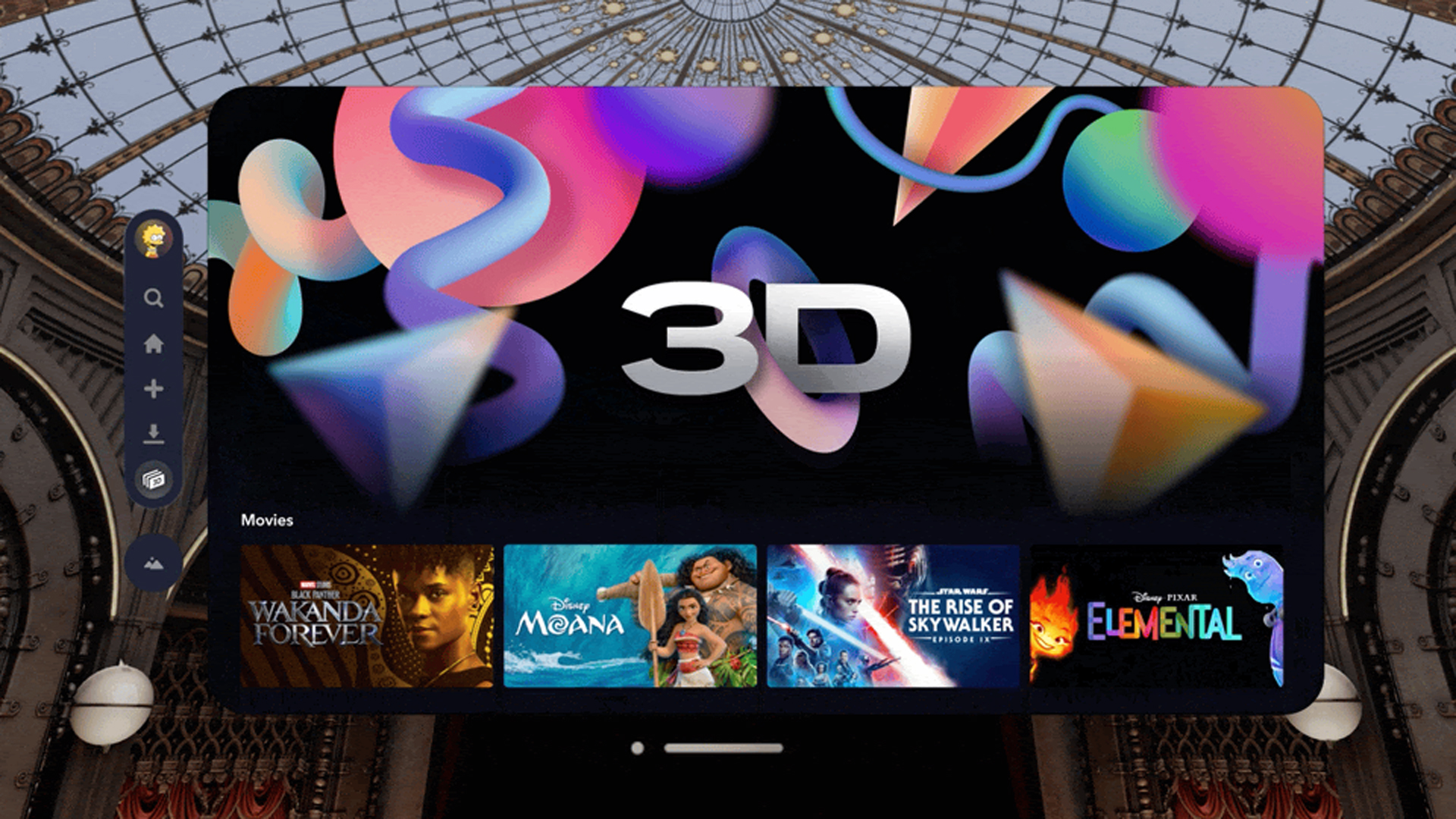
I’ve previously discussed how it’s an open secret that the simplest (and really the only) way to watch blockbuster 3D movies on a Quest headset involves some level of digital piracy.
3D movie files are difficult to acquire, and 3D movie rental services from the likes of Bigscreen aren’t currently available. And I’ve also complained how absurd this is because, as James Cameron points out, using your VR headset for cinema is superb, because it immerses you in your own portable, private theater.
So while the prospect of the Meta Quest 4 boasting high-end displays for visual excellency is enticing, I’m more concerned about how Meta will tackle its digital content library issue.
The simplest solution would be to form streaming deals like Apple did with Disney Plus. Disney’s service on the Vision Pro allows users to watch Disney’s 3D content library at no additional charge – though it frustratingly appears to be some kind of exclusivity deal, based on the fact the same benefits are yet to roll out to other headsets or the best AR smart glasses for entertainment.
Another option – which Cameron points to – is for Meta to make exclusive deals with creatives directly, so they create new 3D films just for Quest, although worthwhile films take time (and a lot of money) to produce, meaning that Meta’s 3D catalog can’t rely on fresh exclusives alone.
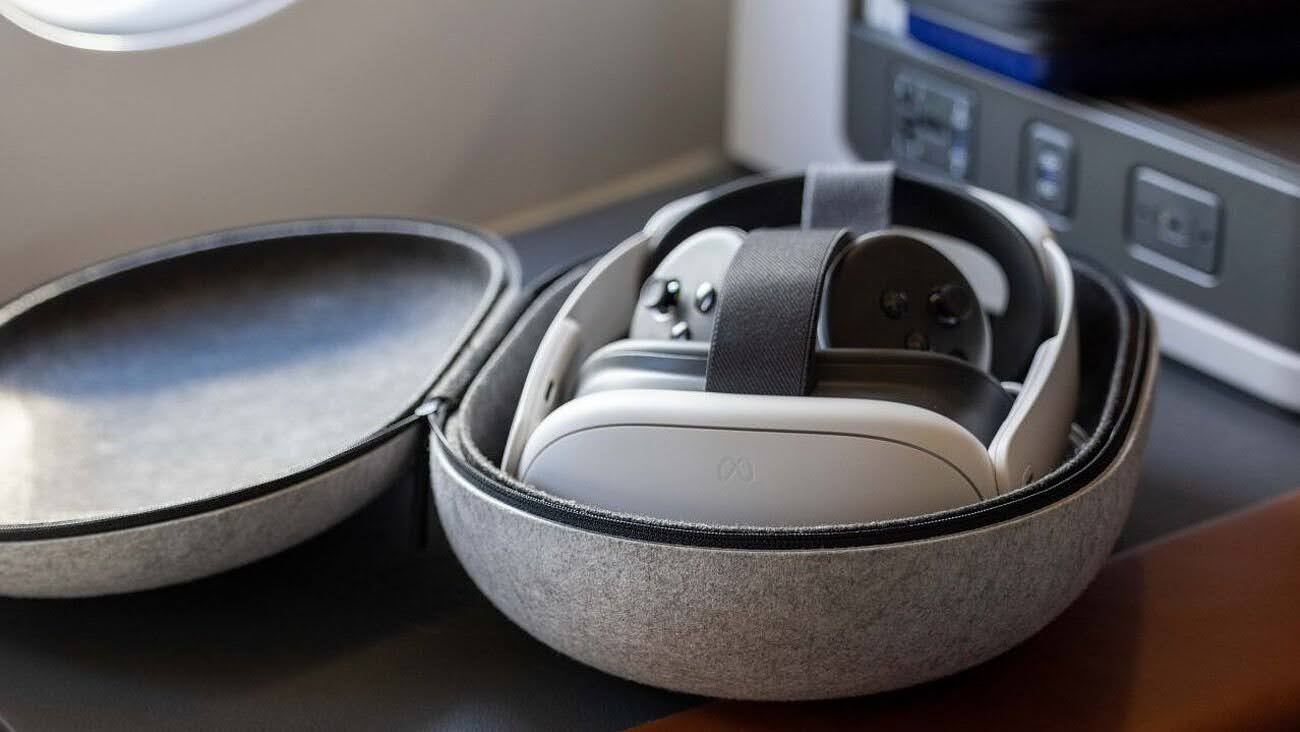
Hopefully this podcast is a sign that Meta is looking to tackle the 3D movies in VR problem from all sides – both hardware and software – as VR entertainment can be superb.
While it is more isolated than the usual home theater experience, the immersive quality or VR, combined with its ability to display your show or film of choice on a giant virtual screen, is a blast.
At the moment the big drawback is the lack of content – but here’s hoping that’s about to change.
You might also like- Google’s surprise Android XR glasses tipped to land in 2026 – and my only complaint is they aren’t launching sooner
- This beginner-friendly train-driving simulator is the chillest Meta Quest 3 game I've played – but it's not for everyone
- You might get a free Meta Quest 3 to use on your next flight, but I'm not keen on the advertising it'll serve you
